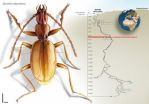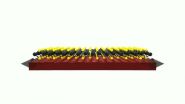(Press-News.org) The unusual habitat of the Krubera cave in the Western Caucasus remains a mystery. Researchers from two Spanish universities have discovered a new species of beetle in the depths of this cave.
Cave beetles are one of the most iconic species found in subterranean habitats. They were historically the first living organisms described by science that are adapted to the conditions of hypogean or subterranean life.
Now, a Portuguese scientist and a Spaniard have discovered a new species of beetle in the deepest cave known to man; a cave 2,140 metres deep. It is the Krubera cave, situated in the Arabika massif in the Western Caucasus.
Ana Sofía Reboleira, researcher from the Universities of Aveiro and La Laguna, and Vicente M. Ortuño, from the University of Alcalá, have published their discovery in the scientific journal 'Zootaxa'.
"The new species of cave beetle is called Duvalius abyssimus. We only have two specimens, a male and a female. Although they were captured in the world's deepest cave, they were not found at the deepest point," Ortuño, who has dedicated the last 10 years to studying subterranean fauna, declared to SINC.
The Duvalius genus is a successful colonizer of the Earth's depths. The majority of species have a hypogean lifestyle and live in caves or the superficial underground compartment.
"The new species' characteristics indicate that it is moderately adapted to life underground. Proof of this is that they still have eyes, which are absent in the highly specialised cave species," added the expert.
The Arabika massif region in Abkhazia, where this cave is found, is biogeographically a very interesting area. Altitudes fluctuate between 1,900 and 2,500 metres and the cave is composed of lower and upper Jurassic-Cretaceous limestone.
Its large area has provided endless subterranean refuges for fauna. In fact, various genera of endemic cave beetles live in the Western Caucasus. "Its location is strategic, since there are fauna of European, Asian and also endemic origin in the zone," the scientist underlined.
The entrance to the cave is 2,240 metres above sea level and 15 kilometres from the Black Sea. Below numerous vertically-cutting sections, it reaches a depth of 1,400 metres. From this level, it splits into branches and in order to reach the greatest known depth, it is necessary to pass various flooded underground chambers using diving techniques.
"The discovery of the new beetle provides important data on species that co-exist in these almost unknown ecosystems, even more so when they are found in a geographical area that is very difficult to access, such is the case with this cave," Ortuño concluded.
INFORMATION:
References:
Ana Sofía Reboleira y Vicente M. Ortuño. "A new species of Duvalius from world's deepest cave (Coleoptera: Carabidae)". Zootaxa 3784 (3): 267�. http://dx.doi.org/10.11646/zootaxa.3784.3.6
A Spaniard and a Portuguese discover a new species of beetle in the world's deepest cave
2014-07-01
ELSE PRESS RELEASES FROM THIS DATE:
Scientists uncover the key to adaptation limits of ocean dwellers
2014-07-01
The simpler, the more heat-resistant – scientists uncover the key to adaptation limits of ocean dwellers
Bremerhaven, Germany, 1 July 2014. The simpler a marine organism is structured, the better it is suited for survival during climate change. Scientists of the Alfred Wegener Institute, Helmholtz Centre for Polar and Marine Research discovered this in a new meta-study, which appears today in the research journal Global Change Biology. For the first time biologists studied the relationship between the complexity of life forms and the ultimate limits of their adaptation ...
The biology of addiction risk looks like addiction
2014-07-01
Philadelphia, PA, July 1, 2014 – Research suggests that people at increased risk for developing addiction share many of the same neurobiological signatures of people who have already developed addiction. This similarity is to be expected, as individuals with family members who have struggled with addiction are over-represented in the population of addicted people.
However, a generation of animal research supports the hypothesis that the addiction process changes the brain in ways that converge with the distinctive neurobiology of the heritable risk for addiction. In other ...
In study of individual neuron activity, key brain region responds to subjective perception
2014-07-01
LOS ANGELES (June 30, 2014) – When evaluating another person's emotions – happy, sad, angry, afraid – humans take cues from facial expressions. Neurons in a part of the brain called the amygdala "fire" in response to the visual stimulation as information is processed by the retina, the amygdala and a network of interconnected brain structures. Some of these regions respond just to the actual features of the face, whereas others respond to how things appear to the viewer, but it is unknown where in the brain this difference arises.
Although the amygdala's importance in ...
Up in flames: Evidence confirms combustion theory
2014-07-01
Researchers at the Department of Energy's Lawrence Berkeley National Lab (Berkeley Lab) and the University of Hawaii have uncovered the first step in the process that transforms gas-phase molecules into solid particles like soot and other carbon-based compounds.
The finding could help combustion chemists make more-efficient, less-polluting fuels and help materials scientists fine-tune their carbon nanotubes and graphene sheets for faster, smaller electronics. In addition, the results could have implications for the burgeoning field of astrochemistry, potentially establishing ...
Study finds online bullying creates off-line fear at school
2014-07-01
HUNTSVILLE, TX (7/1/14) -- Cyberbullying creates fear among students about being victimized at school, a recent study by Sam Houston State University found.
While traditional bullying still creates the most fear among students, cyberbullying is a significant factor for fear of victimization at school among students who have experienced bullying or disorder At school, such as the presence of gangs. The fear from cyberbullying is most prominent in minority populations.
"It cannot be overstated – online victimization has offline consequences, and those consequences may ...
Scientists discover how plastic solar panels work
2014-07-01
This news release is available in French.
Scientists don't fully understand how 'plastic' solar panels work, which complicates the improvement of their cost efficiency, thereby blocking the wider use of the technology. However, researchers at the University of Montreal, the Science and Technology Facilities Council, Imperial College London and the University of Cyprus have determined how light beams excite the chemicals in solar panels, enabling them to produce charge. "Our findings are of key importance for a fundamental mechanistic understanding, with molecular ...
Stanford engineers envision an electronic switch just 3 atoms thick
2014-07-01
VIDEO:
This animation shows the three-atom thick crystal being pulled from a non-conductive to conductive state, and then being pushed back to the non-conductive state.
Click here for more information.
Do not fold, spindle or mutilate. Those instructions were once printed on punch cards that fed data to mainframe computers. Today's smart phones process more data, but they still weren't built for being shoved into back pockets.
In the quest to build gadgets that can survive such ...
Updated guidelines covering fusion procedures for degenerative disease of the lumbar spine
2014-07-01
Charlottesville, VA (July 1, 2014). Experts in the spine surgery community—neurosurgeons and orthopedic surgeons—banded together to evaluate the recent literature on lumbar spine fusion procedures and to publish up-to-date evidence-based recommendations on their use. The Journal of Neurosurgery: Spine is pleased to announce today's publication of the American Association of Neurological Surgeons/Congress of Neurological Surgeons Joint Section on Disorders of the Spine and Peripheral Nerves' updated guidelines for the performance of fusion procedures for degenerative disease ...
Freeze-storage egg banking for egg donation treatment
2014-07-01
Munich, 1 July 2014: The rapid freezing technique of vitrification is set to revolutionise egg donation as a fertility treatment by enabling freeze-storage egg-banking. The cryopreservation of eggs was one of IVF's continuing challenges until the widespread introduction of vitrification; the older slow freezing methods induced the formation of ice crystals, which could cause damage to several structures of the egg. Thus, as demand for egg donation increases as a treatment for age-related infertility, egg banking with vitrification can theoretically provide a large pool ...
Preconceptional factors in the prediction of fertility and the reproductive lifespan
2014-07-01
Munich, 1 July 2014: A project in Denmark whose aim is to assess the reliability of preconceptional lifestyle and biological factors as predictors of fertility has found a pronounced effect of the contraceptive pill on markers used to assess "ovarian reserve", a predictor of future reproductive lifespan. Available evidence of whether the Pill has an effect on fertility has so far been reassuring - and usual advice to those stopping the Pill is that cycles will soon revert to normal, with pregnancy likely within six months or so.(1)
However, one continuing concern ...




